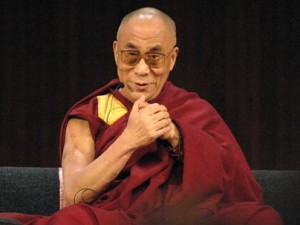SEARCHING FOR ROOTS OF COMPASSION
IN MIT VISIT, DALAI LAMA CALLS FOR ETHICS IN A SECULAR AGE

Photo / Donna CoveneyTenzin Gyatso, the 14th Dalai Lama,
addresses the crowd at MIT’s
Kresge Auditorium on Thursday, April 30.
Tenzin Gyatso, the 14th Dalai Lama, exhorted a packed audience at Kresge Auditorium on Thursday, April 30, to work toward a more compassionate world, emphasizing that a loving and ethical life can be based on any religion, or on no religion.
In his second visit to MIT, the Dalai Lama dedicated a new center created in his name: The Dalai Lama Center for Ethics and Transformative Values, which is part of the Office of Religious Life at MIT. The center, which will partner with members of the MIT community to explore spiritual, ethical and religious questions, will be directed by MIT’s Buddhist chaplain, Tenzin Priyadarshi.
“Open heartedness, compassion — it’s a capacity from birth,” the Dalai Lama said in his address. “It must be possible to increase that.” He said all humans have an innate, biologically based level of compassion, but it is limited. However, there is also a higher level — an “infinite, unbounded tendency toward compassion.” This comes from a “biological seed,” he said, but “there’s potential to increase that,” just as knowledge can be increased by education.
If people have no religious belief, the Dalai Lama said, those people’s ethical and compassionate feelings are “not coming from a religious idea, but simply by nature.” Most people today, he said, are not very serious about religion, even if they visit a church, mosque or temple occasionally. “The majority of the 6 billion people [on the planet], I think, you can count as non-believers. We must find ways and means for promotion of these values” of ethics and compassion among these non-believers, he said.
He said that some people see secularism as “rejection of all religions, some say secularism means respect for all religions.” He added that, “I expect [it is] not a rejection of religion. There is no reason to reject all religions.” All of the major religions teach “forgiveness, tolerance, respect — no one would argue these are bad.”
“I say secularism means respect all religions equally — no preferences [for] this religion, that religion. I’m Buddhist: from my perspective Buddhism is best, but that does not mean Buddhism is best for everyone.” It is best, “for my practice, my tradition, that’s all. I respect, genuinely respect, Christianity, Islam, Judaism … I really respect all religions, secularly. I also respect non-religious people.”
The Dalai Lama spoke for about 45 minutes before taking questions from the audience. When asked by an audience member how he should respond if his job required him to work on weapons, the Dalai Lama replied that “our aim should be to demilitarize the world, hopefully later this century.” Until that is achieved, he said, such personal decisions will be difficult to make, but he emphasized that violence doesn’t come from weapons but from their users. “So I usually call for inner disarmament,” he said. “Inner disarmament is easy to achieve. External, difficult.”
Before his appearance at Kresge, on Wednesday the Dalai Lama took part in a tree-planting ceremony outside Simmons Hall, and then viewed a sand mandala that has been created there over the past week. He also made an appearance at Harvard, and addressed a gathering on Saturday at Gillette Stadium in Foxborough, Mass.
Chaplain Tenzin Priyadarshi said that the Dalai Lama Center faces an important task, given the “unprecedented crisis” in the world’s economy today. “The world is in need of clarity and hope.” The economic recession has been accompanied by “a recession in hope and values,” and it is important to address these needs, he said.
Commenting on the creation of the new center, Chaplain to the Institute Robert Randolph said that “people will look back on this day as the beginning of something really important for the MIT community. We need to find ways for our students to have access to the best of contemporary thinking” on issues of ethics. “This is an exciting moment.”
A version of this article appeared in MIT Tech Talk on May 6, 2009 (download PDF).
